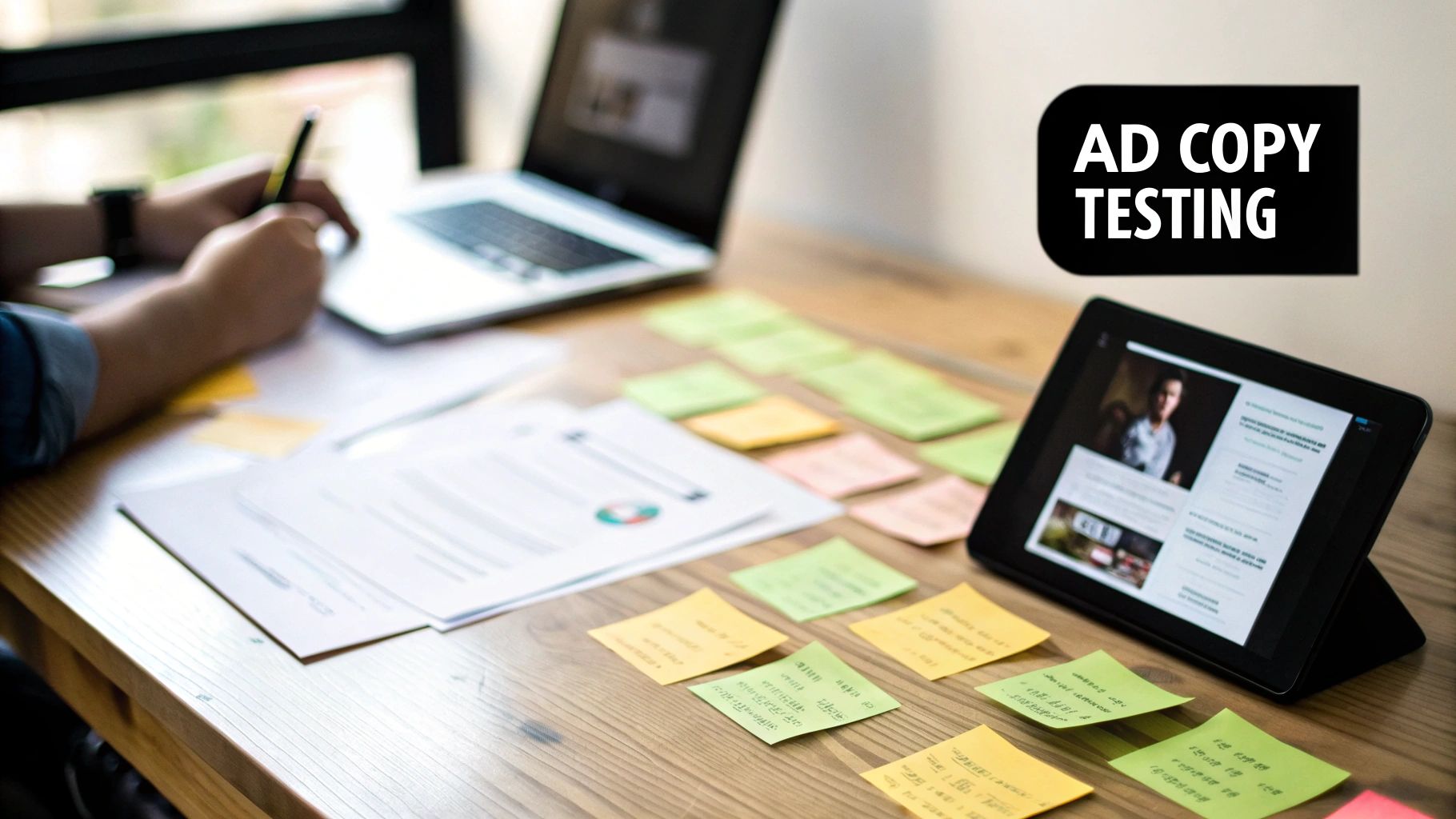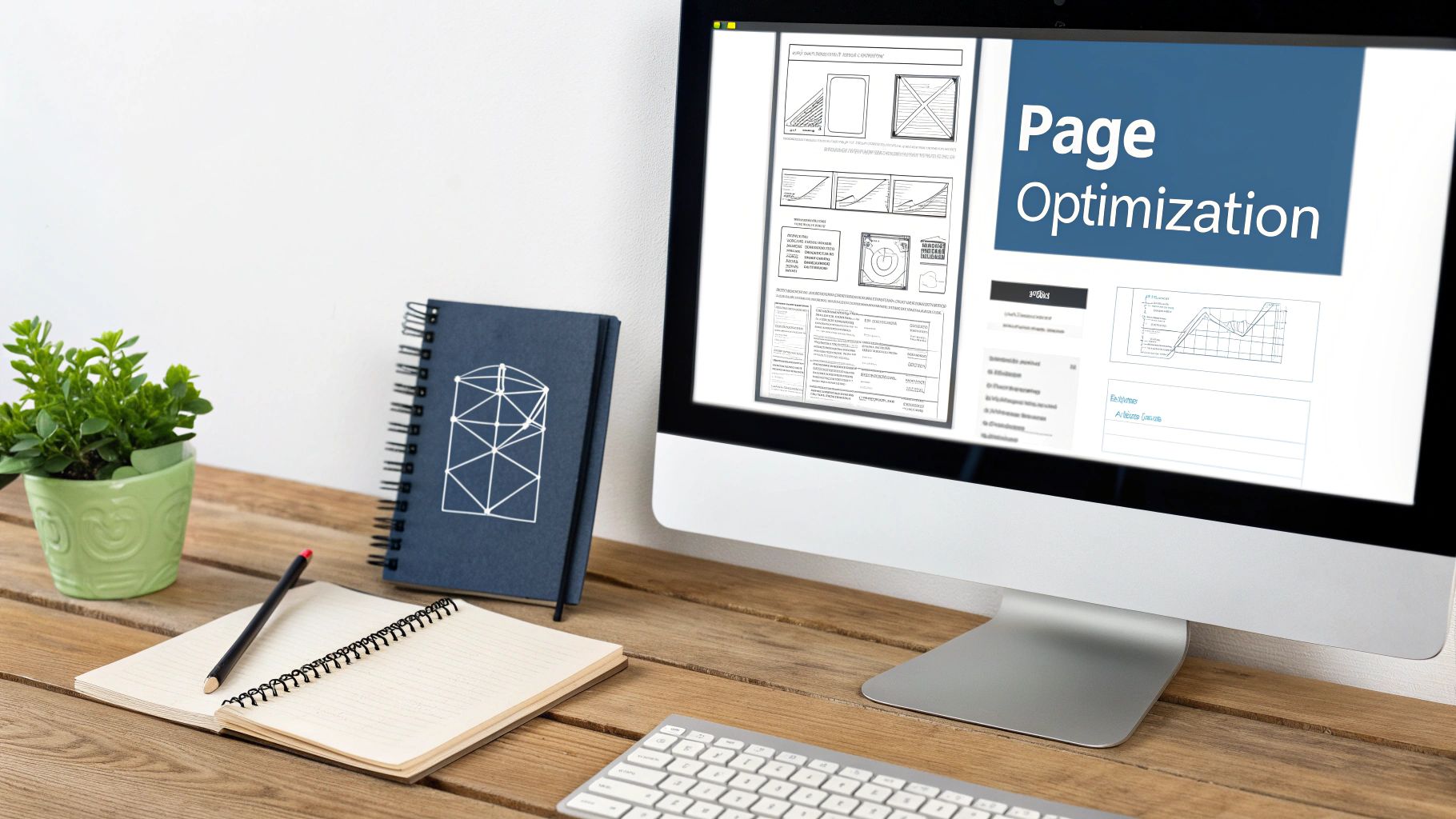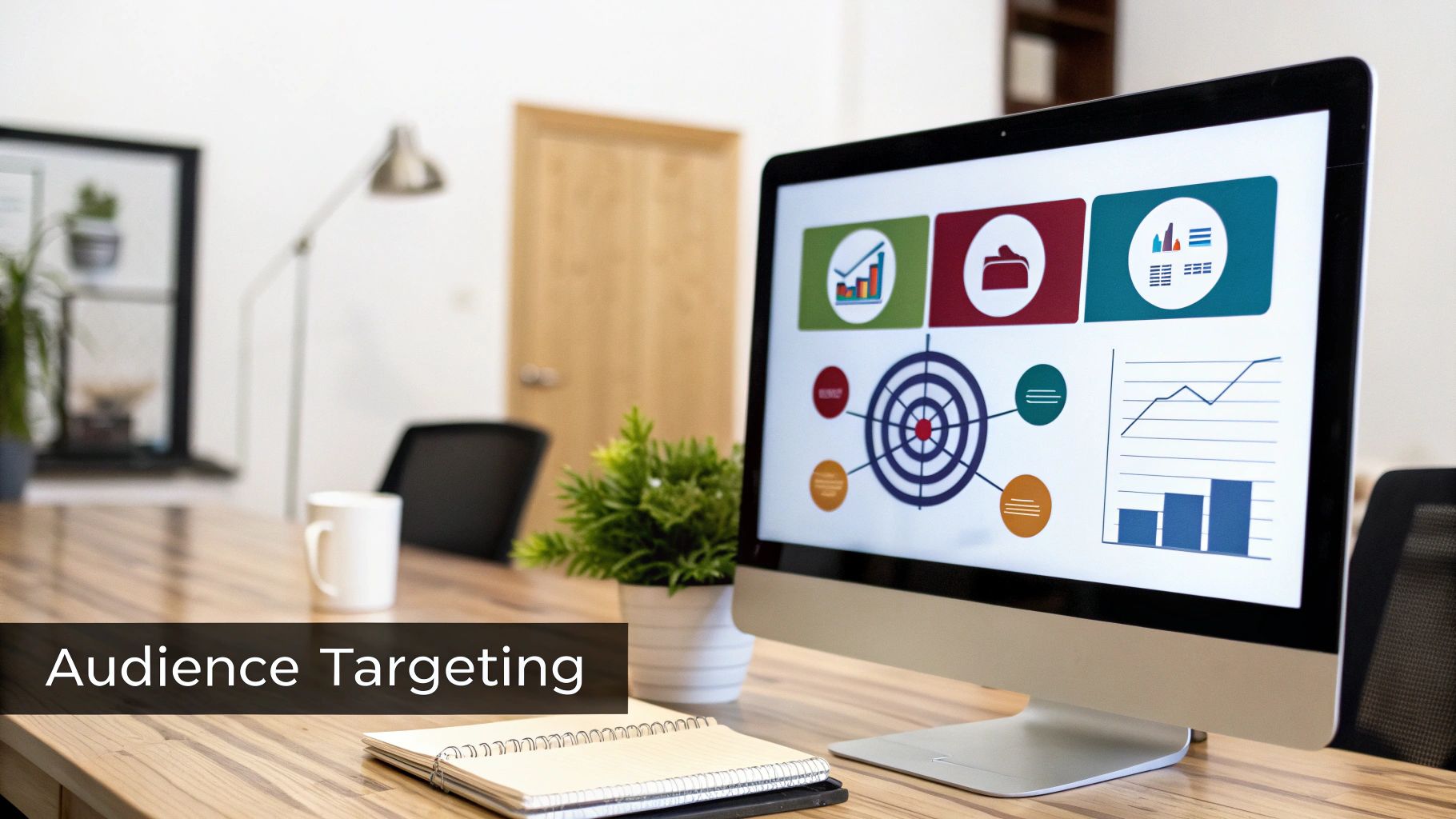July 28, 2025
Your 8-Point PPC Campaign Checklist for 2025


Jumping into a pay-per-click campaign without a solid plan is like trying to build a house without blueprints. You'll waste a lot of time, burn through your budget, and end up with something that just doesn’t work. The difference between a campaign that flops and one that fuels growth often comes down to a methodical, strategic approach. That’s where a detailed ppc campaign checklist becomes your most valuable tool, turning potential chaos into a clear, repeatable process for success.
This isn't just another list of vague tips. We're breaking down the entire PPC lifecycle into actionable, manageable stages. From pinpointing the perfect keywords and crafting compelling ad copy to optimizing your landing pages and mastering your bidding strategy, this guide covers every critical step. Before we dive into the checklist, it's worth noting how modern tools are reshaping this process. For a deeper understanding of the technologies driving today's strategies, exploring a guide on artificial intelligence in marketing can provide valuable context on automation and optimization.
Think of this article as your co-pilot, ensuring you don’t miss a single crucial detail from setup to launch and beyond. Let's get your campaigns structured for maximum impact and ROI from day one.
1. Keyword Research and Selection
Think of keywords as the very foundation of your PPC house. If the foundation is cracked and built on shaky ground, the entire structure will eventually crumble, no matter how great your ad copy or landing pages are. Keyword research is the process of finding the specific search queries your ideal customers are typing into Google. This is a non-negotiable first step in any successful PPC campaign checklist.

The goal isn't just to find any keywords; it's to find the right ones. You're looking for terms that signal strong purchase intent, align with your offerings, and won't completely drain your budget. A local pizza shop, for example, would see far more success targeting "pizza delivery near me" than a broad, expensive term like "food."
Why It's a Must-Have
Effective keyword selection directly impacts your campaign's ROI. By targeting relevant, high-intent keywords, you ensure your ads are shown to users who are actively looking for a solution you provide. This leads to higher click-through rates (CTR), better Quality Scores, and ultimately, a lower cost-per-acquisition (CPA). Neglecting this step is like fishing in the ocean without bait - you might get lucky, but it's not a strategy.
Actionable Tips for Implementation:
- Focus on Intent: Go beyond just high search volume. Prioritize keywords that show someone is ready to buy, like "emergency plumber service" versus "how to fix a leaky faucet."
- Structure with Themes: Group 5-20 tightly related keywords into a single ad group. For instance, a group for a SaaS company might include "project management software," "best pm tools," and "team collaboration platform."
- Mine Your Search Terms: Regularly dive into your Search Term Report in Google Ads. This report shows you the actual queries that triggered your ads, revealing golden opportunities for new keywords and essential negative keywords to cut wasted ad spend.
Tools can significantly simplify this process. While Google's Keyword Planner is a great starting point, platforms like Keywordme are specifically designed to streamline this workflow, helping you discover high-converting terms and automate your keyword research.
2. Ad Copy Creation and Testing
If keywords are the foundation, your ad copy is the front door. It’s the very first interaction a potential customer has with your brand in the search results. Effective ad copy grabs attention, communicates value, and persuades the user to click. This step in your PPC campaign checklist is about crafting compelling messages that resonate directly with your target audience and stand out from the competition.

The art lies in balancing creativity with relevance. You need to incorporate your target keywords naturally while also speaking the language of your customer. Think of Dollar Shave Club's famously direct and humorous copy that completely disrupted an established industry. They didn’t just sell razors; they sold a smarter, funnier way to shave, and their ad copy reflected that perfectly.
Why It's a Must-Have
Your ad copy is a primary driver of your click-through rate (CTR), which is a major component of your Quality Score. A higher Quality Score means Google sees your ads as more relevant, rewarding you with better ad positions and a lower cost-per-click (CPC). In short, great ad copy directly leads to getting more traffic for less money. It’s your chance to answer the user's unspoken question: "Why should I click on your ad instead of the others?"
Actionable Tips for Implementation:
- Mirror the Searcher's Mind: Include your primary keyword in Headline 1. This immediately confirms to the user that your ad is relevant to their search query, building instant trust.
- Leverage Emotion and Urgency: Use trigger words that evoke emotion or create a sense of urgency. Phrases like "Limited Time Offer," "Don't Miss Out," or "Get Instant Relief" can significantly boost clicks.
- Test Your Calls-to-Action (CTAs): Don't just settle for "Learn More." Experiment with more direct and benefit-driven CTAs like "Get Your Free Quote," "Start Your Trial," or "Shop the Sale."
- Use Ad Extensions: Maximize your ad's real estate on the search results page. Sitelinks, callouts, and structured snippets give users more information and more reasons to click your ad over a competitor's.
3. Landing Page Optimization
Your ad is the promise, but your landing page is the fulfillment. If a user clicks your compelling ad only to land on a slow, confusing, or irrelevant page, you've not only lost a potential customer, you've paid for the privilege. Landing page optimization is the art and science of creating a seamless post-click experience designed to convert visitors into leads or customers.

This step is critical because a strong landing page experience directly influences your Google Ads Quality Score. A better score means lower ad costs and higher ad rankings. Think of high-converting pages like those from Unbounce or Leadpages, where a clear value proposition, focused design, and a single call-to-action work together to guide the user toward a specific goal. This element is an indispensable part of any modern PPC campaign checklist.
Why It's a Must-Have
A poor landing page is like having a fantastic storefront with a locked door. You can drive all the traffic in the world, but if users can't get what they came for, your ad spend is wasted. Optimizing your landing page improves conversion rates, which means you get more value from the clicks you're already paying for. This directly increases your campaign's ROI and profitability without needing to increase your budget.
Actionable Tips for Implementation:
- Maintain Message Match: Ensure the headline and core message of your landing page perfectly mirror the ad copy the user clicked. If your ad promises a "50% Off Emergency Plumbing," the landing page must immediately reinforce that offer, not send them to a generic homepage.
- A/B Test Everything: Don't guess what works. Continuously test different headlines, button colors, form lengths, images, and calls-to-action. Use these tests to make data-driven decisions that systematically improve performance over time.
- Optimize for Mobile and Speed: The majority of clicks often come from mobile devices. Your page must load quickly and be easy to navigate on a small screen. Simplify forms, use large tap targets, and compress images to ensure a smooth mobile experience.
- Build Trust Instantly: Incorporate social proof like customer testimonials, reviews, trust badges (e.g., security seals, industry awards), and case studies to alleviate user anxiety and build credibility right away.
Once your landing pages are live, ongoing improvements are essential. Learn more about leveraging advanced Conversion Rate Optimization strategies to maximize your campaign's effectiveness.
4. Bidding Strategy Configuration
Think of your bidding strategy as the engine powering your PPC vehicle. It determines how much you're willing to pay for a click and ultimately dictates the pace and efficiency of your campaign's journey toward its goals. Choosing the right bidding strategy is a critical decision in any PPC campaign checklist, as it directly aligns your ad spend with your desired outcomes, whether that's brand awareness, lead generation, or sales.

The choice isn't just about setting a price; it's about telling Google what you value most. For example, an e-commerce brand might use a Target ROAS (Return On Ad Spend) strategy to ensure every dollar spent generates a profitable return. In contrast, a new business might use Maximize Clicks to drive as much initial traffic as possible to their new website.
Why It's a Must-Have
Your bidding strategy is where your budget meets your business objectives. A misaligned strategy can lead to massively overspending for low-quality leads or, conversely, missing out on valuable customers by bidding too conservatively. Properly configured bidding, especially with Google's powerful Smart Bidding technology, leverages machine learning to optimize bids in real-time for each auction, a task impossible to do manually at scale. This leads to better performance, improved efficiency, and a clearer path to achieving your campaign goals.
Actionable Tips for Implementation:
- Start with Control, Then Automate: For brand new campaigns with no conversion history, start with Manual CPC or Enhanced CPC. This allows you to gather crucial performance data and establish a baseline. Once you have at least 30 conversions in a 30-day period, you'll have enough data to confidently switch to an automated strategy like Target CPA or Maximize Conversions.
- Match Strategy to Your Goal: Don't just pick the default. If your goal is generating leads at a specific cost, use Target CPA. If you're an e-commerce store focused on profitability, Target ROAS is your best bet. If you want sheer volume of traffic for a top-of-funnel campaign, consider Maximize Clicks.
- Monitor Transitions Closely: When you switch from a manual to an automated strategy, expect a learning period of 5-7 days. During this time, Google's algorithm is gathering data, and performance might fluctuate. Avoid making major changes during this window and monitor results carefully.
5. Audience Targeting and Segmentation
If keywords are the foundation of your PPC house, audience targeting is the blueprint that dictates who is allowed inside. You could have the best keywords in the world, but if you're showing your ads to the wrong people, you're essentially hosting a party for guests who have no interest in what you're offering. Audience targeting is the process of defining and reaching specific groups of users based on who they are, what they're interested in, and how they've interacted with you before.
This step is a core component of any modern PPC campaign checklist because it allows you to move beyond just keywords and focus on the person behind the search. For example, a B2B software company can go beyond a keyword like "CRM for small business" and specifically target users with job titles like "Sales Manager" or "Business Owner" who work in the technology industry. This layering of signals transforms a broad approach into a highly precise one.
Why It's a Must-Have
Effective audience targeting dramatically increases campaign efficiency and ROI. By focusing your budget on the most qualified prospects, you avoid wasting money on clicks from irrelevant users. This leads to higher conversion rates, a more relevant ad experience for the user, and a stronger connection with potential customers. Neglecting this means you're treating every searcher the same, which is a fast track to a high cost-per-acquisition (CPA) and lackluster results.
Actionable Tips for Implementation:
- Layer Your Targeting: Don't just rely on one audience type. Combine demographics (e.g., age, income) with in-market audiences (e.g., people actively researching your product category) and your own remarketing lists for hyper-specific targeting.
- Leverage Remarketing: Create lists of past website visitors, cart abandoners, or existing customers. You can then serve tailored ads to re-engage these warm leads who are already familiar with your brand, often resulting in a higher conversion rate.
- Use Exclusion Lists Wisely: Just as important as who you target is who you exclude. For instance, if you have a campaign targeting new customers, be sure to exclude your existing customer list to prevent wasted ad spend and ensure your messaging is appropriate.
Mastering how to define, segment, and reach your ideal customers is critical for success. For a deeper exploration of the different methods available, you can learn more about Google Ads audience targeting on keywordme.io.
6. Conversion Tracking Implementation
Imagine running a PPC campaign without knowing if it's actually making you money. That's what you're doing if you skip conversion tracking. It's the nervous system of your advertising efforts, telling you exactly which ads, keywords, and campaigns are driving valuable actions like sales, sign-ups, or phone calls. Without it, you're just spending money in the dark, hoping something sticks. This is an absolutely essential component of any serious PPC campaign checklist.
The goal is to connect your ad clicks to real business outcomes. For an e-commerce store, this is a completed purchase. For a service business, it might be a submitted contact form or a call from a potential lead. By implementing tracking, you're giving the ad platform the data it needs to optimize for what truly matters, not just for clicks.
Why It's a Must-Have
Accurate conversion tracking is the only way to measure your return on investment (ROI). It allows you to make data-driven decisions, shifting your budget from underperforming assets to the ones that deliver results. It also unlocks powerful automated bidding strategies like "Maximize Conversions" or "Target CPA," which rely on conversion data to function effectively. Neglecting this step means you're flying blind, unable to prove or improve your campaign's value.
Actionable Tips for Implementation:
- Test Before You Launch: Always test your conversion actions to ensure they are firing correctly before your campaign goes live. Use Google Tag Assistant or the platform's built-in testing tools to verify the setup and avoid collecting faulty data from day one.
- Use Google Tag Manager (GTM): For easier and more flexible implementation, manage your tracking codes (or "tags") through GTM. It allows you to add and update tracking for Google Ads, Analytics, and other platforms without having to constantly edit your website's code.
- Audit Your Tracking Regularly: Don't just set it and forget it. Website updates can sometimes break tracking codes. Schedule a quarterly audit to confirm all your conversion points are still reporting accurately, ensuring the integrity of your performance data. You can learn more about setting up Google Ads conversion tracking to master this process.
7. Budget Allocation and Management
Think of your PPC budget as the fuel for your advertising engine. Pour it all in at once, and you'll burn out before reaching your destination. Drip it in too slowly, and you'll never build enough momentum. Strategic budget allocation is the art and science of providing the right amount of fuel to the right parts of your engine at the right time to maximize performance and travel the farthest on every dollar.
The goal is to distribute your funds intelligently across campaigns, ad groups, and specific time periods. It’s not just about setting a daily cap and hoping for the best. A retail brand, for example, will strategically shift a larger portion of its budget to its "Black Friday Deals" campaign in November, while a B2B company might allocate more funds to campaigns targeting high-value, bottom-of-funnel keywords like "enterprise CRM pricing."
Why It's a Must-Have
Effective budget management is the difference between a profitable campaign and a money pit. By strategically allocating funds, you ensure your top-performing campaigns have the resources they need to scale, while preventing underperforming areas from draining your spend. This is a critical component of any comprehensive ppc campaign checklist because it directly controls your campaign's reach, longevity, and ultimately, its return on investment. Ignoring it is like driving a high-performance car with a leaky gas tank.
Actionable Tips for Implementation:
- Pace and Scale: Start new campaigns with a conservative budget to gather performance data. Once you identify a winner with a strong ROAS, confidently scale its budget up. Don't be afraid to pull back from campaigns that aren't delivering.
- Leverage Shared Budgets: For a set of related campaigns (e.g., targeting different geographic areas for the same service), use a shared budget. This allows Google to automatically allocate more spend to the campaigns that are performing better on any given day, maximizing efficiency.
- Monitor Impression Share: Keep a close eye on the "Search Impression Share Lost (Budget)" metric. If this number is high, it's a clear signal that your campaign is performing well but is being held back by its budget. This is a prime candidate for a budget increase.
8. Performance Monitoring and Optimization
Launching your PPC campaign is the starting line, not the finish line. Think of performance monitoring and optimization as the ongoing coaching and training your campaign needs to win the race. It’s the continuous process of tracking key metrics, analyzing what the data tells you, and making smart, data-driven adjustments to improve your results. This is an essential, never-ending part of any successful PPC campaign checklist.
The goal is to move beyond simply "running" ads and start actively steering them toward your business goals. For example, a travel aggregator like Booking.com doesn't just launch ads and hope for the best; they are famous for their extensive testing and optimization programs, constantly tweaking every element to shave cents off their cost-per-acquisition and boost booking value.
Why It's a Must-Have
Without diligent monitoring and optimization, your campaign is running on autopilot straight into a wall of wasted ad spend. This process is how you identify what's working and what isn't, allowing you to double down on your winners and cut your losses. It turns your ad spend from a blind expense into a calculated investment, directly improving your ROI by systematically lowering your CPA and increasing your conversion rates.
Actionable Tips for Implementation:
- Focus on Business Metrics: Don't get lost in vanity metrics like impressions. Concentrate on the KPIs that directly impact your bottom line, such as Cost Per Acquisition (CPA), Return On Ad Spend (ROAS), and Conversion Rate.
- Set Up Automated Alerts: Use Google Ads' automated rules or third-party tools to create alerts for significant performance shifts. Get notified immediately if your CPA spikes by 20% or if a keyword's CTR drops dramatically, allowing you to react quickly.
- Standardize Your Reporting: Create a clear, consistent reporting template. Whether it’s weekly or monthly, a standardized report helps you spot trends and anomalies more easily over time. Tools like Google Data Studio can make this visual and straightforward.
8-Step PPC Campaign Checklist Comparison
Your Next Steps for PPC Domination
There you have it – the ultimate PPC campaign checklist, broken down into manageable, actionable steps. We've navigated the entire paid search landscape, from laying a solid foundation with meticulous keyword research and account structure to fine-tuning the engine with advanced bidding strategies and relentless performance monitoring. This isn't just a one-and-done list to be ticked off at launch. Think of it as your recurring roadmap, a trusted guide you can return to every week and every month to ensure your campaigns are not just running, but thriving.
The difference between a good PPC campaign and a great one lies in the details. It's about moving beyond simply setting a budget and choosing some keywords. True success comes from the synergy between compelling ad copy, a frictionless landing page experience, and hyper-specific audience targeting. Each element we've covered, from implementing robust conversion tracking to strategically segmenting your audiences, is a critical gear in your revenue-generating machine. Neglecting one can cause the entire system to grind to a halt.
Key Takeaways for Lasting Success
So, what are the most critical takeaways?
- Never Stop Testing: Complacency is the enemy of a high-performing PPC account. A/B test everything: your headlines, your calls to action, your landing page layouts, and your bidding models. What works today might not work tomorrow, and continuous testing is your only defense.
- Data is Your Co-Pilot: Don't make decisions based on gut feelings. Your conversion tracking data is the undisputed source of truth. Dive into your analytics to understand which keywords, ads, and audiences are driving real value, and be ruthless about cutting what isn't working.
- Think Beyond the Click: Getting the click is only half the battle. The user journey continues on your landing page. If you've nailed your PPC setup but are seeing poor conversion rates, the problem often lies post-click. For a broader perspective on improving your overall website's performance beyond PPC, explore a comprehensive conversion optimization checklist to ensure you're maximizing every visit.
Ultimately, mastering this PPC campaign checklist is about adopting a mindset of continuous improvement. It’s about being a strategist, a scientist, and a creative all at once. By diligently applying these principles, you're not just launching ads; you're building a predictable and scalable growth channel for your business. So, bookmark this page, integrate these steps into your workflow, and get ready to watch your ROI climb to new heights.
Ready to streamline your keyword research and optimization process? Keywordme helps you discover high-intent keywords, analyze competitor strategies, and organize your campaigns with powerful AI-driven tools, turning this checklist into an even more efficient workflow. Try Keywordme today and take the guesswork out of your PPC strategy.


.svg)